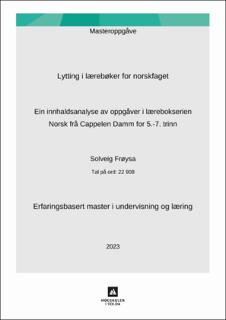| dc.contributor.author | Frøysa, Solveig | |
| dc.date.accessioned | 2023-07-04T07:10:37Z | |
| dc.date.available | 2023-07-04T07:10:37Z | |
| dc.date.issued | 2023 | |
| dc.identifier.uri | https://hdl.handle.net/11250/3075448 | |
| dc.description.abstract | Munnlege ferdigheiter er ei av fire grunnleggande ferdigheiter i læreplanen i norsk, og lytting er ein viktig del av munnlegheit. Føremålet med denne masteroppgåva er å undersøke korleis lærebøker legg opp til at elevane skal arbeide med lytting, og korleis dette heng saman med krava om lytting i læreplanen. Lærebøker dominerer i mange norske klasserom, og skal fortrinnsvis møte krava til læreplanen. Å undersøke oppgåvene i lærebøkene, gir innsikt i kva som kan tolkast som kjernen i faget. Problemstillinga for oppgåva er: Korleis vert lytting i læreplanen i norsk (NOR01-06) operasjonalisert gjennom oppgåvetekstar i utvalde lærebøker i norsk for 5. til 7. trinn?
For å svare på problemstillinga, har eg gjennomført to innhaldsanalysar – ein læreplananalyse og ein lærebokanalyse. Læreplananalysen er gjort ved å søke på ord knytte til lytting i den utvalde delen av læreplanen, i tillegg til ei heilskapleg gjennomlesing av teksten. I lærebokanalysen er oppgåvene sorterte i ulike kategoriar for lytting. Begge analysane er utarbeida på bakgrunn av teori og mi eiga lesing av tekstane. I læreplananalysen har eg delvis støtta meg til lytteforskaren Hildegunn Otnes, medan eg i lærebokanalysen lener meg til ein lyttemodell av den svenske lytteforskaren Kent Adelmann.
Hovudfunna i oppgåva er at lytterolla deltakar, der lyttar og talar har lik rett på ordet, er dominerande i både læreplan og lærebokoppgåver. Begge analysane synleggjer skjulte føringar for lytting, og det er lite vekt på opplæring i lytting i både læreplan og lærebok. Mellom dei tre lærebøkene er det ei stor skeivfordeling av oppgåver knytt til lytting, og talet på lytteoppgåver minkar med auke i årstrinn. Dette verkar å stri med krava i læreplanen om å utvikle dei munnlege ferdigheitene på alle trinn. I tillegg er det i stor grad opp til lærebokforfattarane å bestemme føremålet med lyttinga og kva lyttehandlingar og -modus oppgåvene skal instruere om, då dette i lita grad kjem til syne i læreplanen. | en_US |
| dc.description.abstract | Abstract
Oracy is one of four basic skills in the curriculum for Norwegian as a subject, and listening is an important part of oracy. The purpose of this master’s thesis is to examine how school textbooks instruct pupils to work with listening, and how this correlates with the listening demands in the curriculum. The textbook is a dominating tool in Norwegian classrooms and will preferably meet the requirements of the curriculum. Examining the tasks in the textbooks gives insight into what can be interpreted as the core of the subject. The research question of this thesis is: How is listening in the curriculum for Norwegian (NOR01-06) operationalized through task texts in the chosen textbooks for Norwegian for 5. to 7. grade?
To answer this research question, I have carried out a content analysis – one analysis of the curriculum and one analysis of the textbooks. The curriculum analysis is done by searching for words connected to listening in the chosen part of the curriculum, in addition to an holistic read through of the text. In the textbook analysis the tasks are sorted into different categories of listening. Both analyses are made on the basis of theory and my own reading of the texts. In the curriculum analysis I have partially leaned on listening researcher Hildegunn Otnes, while I’m in the textbook analysis leaning on a model for listening by the Swedish listening researcher Kent Adelmann.
The main findings in this study is that the listening role participant, where the listener and the speaker have the same proximity to the spoken word, is dominating in both the curriculum and the textbook tasks. Both analysis shed light on hidden leads on listening, and training listening is emphasized to a small extent in both curriculum and textbooks. Between the three textbooks there is a skewed distribution of tasks related to listening, and the number of listening tasks decreases with increasing year level. This seems to contend with the demands in the curriculum about developing the oracy on all year levels. Besides this it is largely up to the textbook writers to decide the purpose of the listening and what listening act and -mode the tasks shall instruct about, since this to a small degree is visible in the curriculum. | en_US |
| dc.language.iso | nno | en_US |
| dc.publisher | Høgskulen i Volda | en_US |
| dc.subject | læreverk | en_US |
| dc.subject | lytting | en_US |
| dc.subject | læreplan norsk | en_US |
| dc.subject | læreplananalyse | en_US |
| dc.subject | lærebokanalyse | en_US |
| dc.title | Lytting i lærebøker for norskfaget. Ein innhaldsanalyse av oppgåver i lærebokserien Norsk frå Cappelen Damm for 5.-7. trinn | en_US |
| dc.type | Master thesis | en_US |
| dc.source.pagenumber | 75 | en_US |
